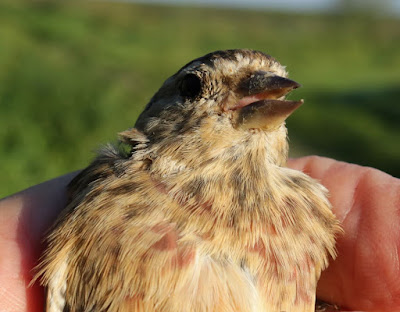I changed the header. It’s a Twite Linaria flavirostris, a close relative of the Linnet Linaria cannabina, a bird featured many times here on Another Bird Blog.
Most people wouldn’t notice a Twite - a small, streaky brown finch whose only colour is a bright pink rump and even that shows only in Spring. The rest of the year, it’s rather retiring and uncommon. Perhaps that’s why it’s disappeared from our uplands almost without us noticing.
Here on the Fylde stretch of coastline in the extreme south of Morecambe Bay, the Twite is a winter visitor and autumn migrant.
I was lucky this morning when two Twite put in an appearance out Pilling Way. Who can resist a few clicks when there’s Linnets and Twite around for direct comparison? A Twite has a distinctive and rather beautiful orange-buff ground colour to the face and the unstreaked throat. Brown streaking extends from the sides of the breast rather diffusely down onto the flanks, but the belly and undertail coverts are white.
Unlike a Linnet, a Twite has an obviously yellow bill in winter, contrasting with the face.
Twite have black feet and legs, a Linnet has paler brown/dark straw coloured legs.
Linnet
Linnet
Twite
Twite
Twite
The morning improved when a Kingfisher flew back and forth for several minutes and where I got the distinct impression there may have been two rather than the single bird that posed briefly. Here at this spot are hundreds of yards of ditches and dykes for Kingfishers and other water birds. Hence the Little Grebe, several Little Egrets and Reed Buntings flitting around the phragmites fringed ditches.
Reed Bunting
Kingfisher
Could it get any better? Well yes when a Merlin flew past pursued by a Crow and then a few minutes later a Marsh Harrier going in the opposite direction. The raptors were the reason for so much Lapwing activity with many 300/400 hundreds flying around in a seemingly random fashion but all the while keeping their distance from danger.
A drive out Cockerham way produced a count of six Cattle Egrets feeding amongst some pretty muddy cows. Of course the egrets are adept at exploiting the churned up ground in which to find their prey of insects and worms that cattle disturb with their feet. The egrets also will sit on cattle to look out for insects but I have only observed this behaviour in the Med and not in the UK.
Cattle Egret
It seems that the six Cattle Egrets weren't the only ones today. Another ten were seen a couple of miles away near the coast at Cockerham. The species may have had a good breeding season in the east with many now heading our way to enjoy the milder Lancashire weather rather than the cold of Europe.
The forecasts for the week ahead don't look too clever but as always where there's a will there could be a way. Stay tuned to Another Bird Blog for the very latest news, views and photos.
































.JPG)















































